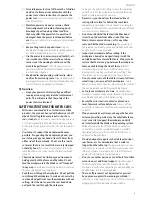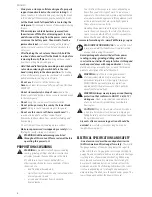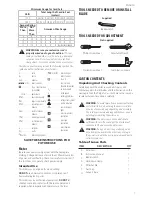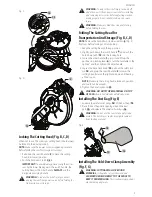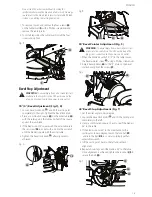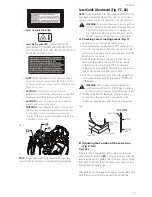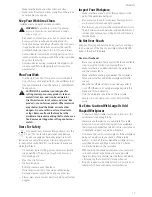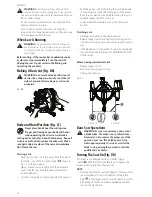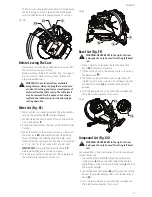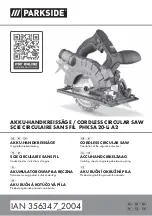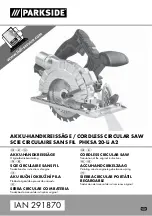
English
6
• Always use a clamp or a fixture designed to properly
support round material such as rods or tubing.
Rods
have a tendency to roll while being cut, causing the blade
to "bite" and pull the work with your hand into the blade.
• Let the blade reach full speed before contacting the
workpiece.
This will reduce the risk of the workpiece being
thrown.
• If the workpiece or blade becomes jammed, turn
the miter saw off. Wait for all moving parts to stop
and disconnect the plug from the power source and/
or remove the battery pack. Then work to free the
jammed material.
Continued sawing with a jammed
workpiece could cause loss of control or damage to the
miter saw.
• After finishing the cut, release the switch, hold the
saw head down and wait for the blade to stop before
removing the cut-off piece.
Reaching with your hand
near the coasting blade is dangerous.
• Hold the handle firmly when making an incomplete
cut or when releasing the switch before the saw
head is completely in the down position.
The braking
action of the saw may cause the saw head to be suddenly
pulled downward, causing a risk of injury.
• Do not use
this saw to cut tree limbs or logs.
• Never
use blades recommended for operation at less than
5000 RPM.
• Do not store materials on top of saw
when in the
folded or unfolded position. Doing so could cause damage
to the lower guard.
• Do not
hang this saw on a wall or other location.
• Do not pick up or carry this saw by the lower blade
guard.
Doing so could cause damage to the guard.
• Do not use this saw to cut fiber cement board.
This
saw is not intended to cut fiber cement board.
• Remove hold-down clamp from saw before folding and
transporting.
• Do not transport the unit standing up in a vehicle.
• Make sure power cord is wrapped up securely
before
folding the saw for storage or transport.
WARNING: Additional warnings are listed
throughout this manual. Please review all before
operating this power tool.
PROPOSITION 65 WARNING
WARNING:
Some dust created by power sanding,
sawing, grinding, drilling, and other construction
activities contains chemicals known to the State
of California to cause cancer, birth defects or
other reproductive harm. Some examples of these
chemicals are:
• lead from lead-based paints,
• crystalline silica from bricks and cement and other
masonry products, and
• arsenic and chromium from chemically-
treated lumber.
Your risk from these exposures varies, depending on
how often you do this type of work. To reduce your
exposure to these chemicals: work in a well ventilated
area, and work with approved safety equipment, such
as those dust masks that are specially designed to
filter out microscopic particles.
Handling the power cord on this product may expose
you to chemicals known to the state of California to
cause cancer and birth defects or other reproductive
harm. Wash hands after handling.
For more information go to: www.P65Warnings.ca.gov
READ INSTRUCTION MANUAL:
To reduce the risk of
injury, user and all bystanders must read instruction
manual before using this product.
•
Avoid prolonged contact with dust from power
sanding, sawing, grinding, drilling, and other
construction activities. Wear protective clothing and
wash exposed areas with soap and water.
Allowing
dust to get into your mouth, eyes, or lay on the skin may
promote absorption of harmful chemicals.
WARNING:
Use of this tool can generate and/
or disperse dust, which may cause serious and
permanent respiratory or other injury. Always use
NIOSH/OSHA approved respiratory protection
appropriate for the dust exposure. Direct particles
away from face and body.
WARNING: Always wear proper personal hearing
protection that conforms to ANSI S12.6 (S3.19)
during use.
Under some conditions and duration
of use, noise from this product may contribute to
hearing loss.
CAUTION:
When not in use, place tool on its side on
a stable surface where it will not cause a tripping or
falling hazard. Some tools will stand upright but may
be easily knocked over.
•
Air vents often cover moving parts and should be
avoided.
Loose clothes, jewelry or long hair can be
caught in moving parts.
ELECTRICAL SPECIFICATIONS AND SAFETY
•
An extension cord must have adequate wire size
(AWG or American Wire Gauge) for safety.
The smaller
the gauge number of the wire, the greater the capacity
of the cable, that is, 16 gauge has more capacity than 18
gauge. An undersized cord will cause a drop in line voltage
resulting in loss of power and overheating. When using
more than one extension to make up the total length,
be sure each individual extension contains at least the
minimum wire size. The following table shows the correct
size to use depending on cord length and nameplate
ampere rating. If in doubt, use the next heavier gauge. The
lower the gauge number, the heavier the cord.





